Here I Stand: Wars of the Reformation is an experience packaged in a game that attempts to boldly cover the political and religious conflicts of early 16th Century Europe. The game focuses on the struggle of religious reformers such as Martin Luther, John Calvin and Ulrich Zwingli as they battle the Papacy for changes in their views of God and religion. The game covers all the action of the period, including wars, marriages and ascendancies to thrones, using a unique Card Driven Game (CDG) system that models both the political and religious conflicts of the period on a single point-to-point map. Over the years, I have been very intimidated by this game, due to its depth, but mostly due to it sheer size. This game is a monster and in order to play the full game, not just the 2-player variant that I am covering in this review, you will need to prepare. I actually worked with Tom Knight to post a play experience that his group had at the end of 2017, which was the 500th Anniversary, where they prepared the game with mini training sessions. After playing the shorter 2-player variant I can definitely see why they did what they did.
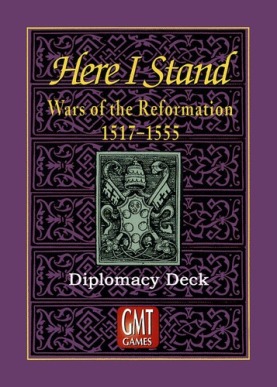 The 500th Anniversary Edition brings some changes to the classic game, including several new cards, errata and changes to the text of existing cards, as well as some added rules from its successor game Virgin Queen. One of the biggest changes in the reprint edition though is the inclusion of a previously released 2-player variant that pits the Protestants versus the Papacy, and which uses a special Diplomacy Deck consisting of 19 cards to drive the actions of the other major powers in the game including England, France, The Ottoman Empire and The Hapsburgs.
The 500th Anniversary Edition brings some changes to the classic game, including several new cards, errata and changes to the text of existing cards, as well as some added rules from its successor game Virgin Queen. One of the biggest changes in the reprint edition though is the inclusion of a previously released 2-player variant that pits the Protestants versus the Papacy, and which uses a special Diplomacy Deck consisting of 19 cards to drive the actions of the other major powers in the game including England, France, The Ottoman Empire and The Hapsburgs.
I am hear to say that I have only had the opportunity to play the 2-player variant. I have not been able to find 4 other players brave enough to invest the time and effort required to play a longer, and more involved game. I have heard from others, and read many times on forums, that the part of Here I Stand that is really great is the diplomacy and alliances that are formed throughout the course of the game. Unfortunately, with the 2-player variant these elements are lacking a little, but that is a subject for a later review. I also want to point out that our experience with the 2-player variant was excellent. We enjoyed ourselves immensely and really were intrigued with the various elements of the “Holy War” that is the focus of the game. There are so many great parts of this game that it is a credit to the design that you can create a 2-player only variant that still has depth.
2-Player Variant
Shortly after the release of Here I Stand: Wars of the Reformation in 2006, Ed Beach released a special 2-player variant in C3i Magazine Nr. 19 that was printed in 2007. This variant was then included in the 500th Anniversary Edition of the game that was released in October 2017. In this variant, one player will play the Protestants trying to spread the Reformation across Europe opposed by the Papal player who represents the established Catholic Church in opposition to this new movement of religious thought.
The four other major powers in the game continue to “influence” play via cards intended to replicate their motives and desired outcome from the Holy War initiated by Martin Luther. The variant includes 19 new cards and the rules run about 3 pages. Playing time for experienced players is under 3 hours. The only other change from the regular game to the variant is that the main deck will be modified. Because only the two powers are playing, players will remove all cards that are referenced to the other powers in the game. Piracy and foreign diplomacy are now abstracted in the Diplomacy Deck via special events, and New World exploration, Henry’s Heirs, France’s Chateaux and other elements of the game are removed because they are unnecessary to the religious struggle over Europe. Let’s now take a closer look at this Diplomacy Deck and try to figure out how it works.
The Diplomacy Deck
What is in the Diplomacy Deck and how does it replicate the grand 6-player experience for only 2-players? The simple answer to the last part of the question is that it doesn’t, but that doesn’t mean that the effort was a total waste. The Diplomacy Deck cards attempt to replicate the actions of the other nations not directly involved in the 2-player variant. I say attempt as the actions are not the same as an aggressive human player would be but still serve a purpose. Some of the cards are simply extra events that can be used directly by the Papacy or Protestant player to affect the game. For example, with the Andrea Doria card, the Papacy can deactivate Genoa from their current ally and then immediately make them an ally. This could be a really key event as the Protestants may have been able to gain Genoa as an ally and was using them to simply slow down the advance of the Papal armies as they are trying to march north to engage Protestant troops.
The other three cards shown are intended to mimic the actions of the other nations in the conflict. With Corsair Raid, the playing side can eliminate enemy ships or force them to discard cards. The Invasion Cards are pretty interesting as well as they will set those nations against your enemy creating fairly powerful forces that will most definitely change the course of their plans.
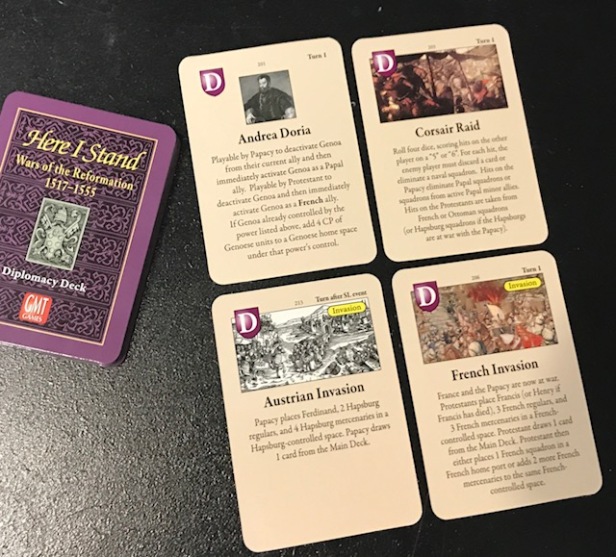
The starting Diplomacy Deck is made up of 12 cards. There are 7 additional cards (marked in the upper right corner with the text “First turn after Schmalkaldic League event”) are added to the deck throughout the process of gameplay. These additions occur at the start of the first turn after the playing of the Schmalkaldic League event. At that time, these additional cards will be added into the deck and it will be reshuffled to form a new “post-SL event deck”.
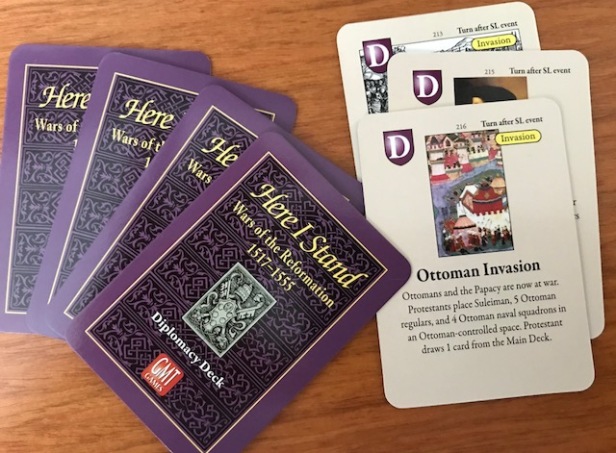
Just a quick look at some of the other cards in this deck. There are a total of 6 different Invasion cards. 4 of these six Invasion cards are controlled by the Protestant player and sets one of the other nations at war with the Papacy. The main reason for this discrepancy is that the Protestants have no option to raise or train troops until the playing of the infamous Schmalkaldic League event, so the 2-player Diplomacy Deck attempts to balance this part of the game by giving the Protestant the chance to set armies against the Papacy.
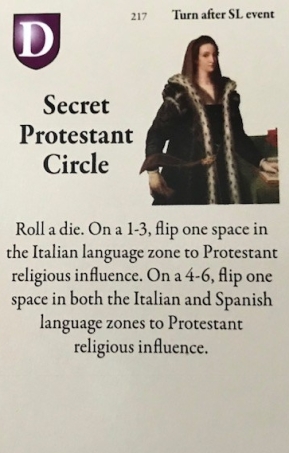 The rest of the cards focus on building naval squadrons for free (Shipbuilding), removing land units from the map (Plague), looking at your opponents hand of Diplomacy Cards and choosing which to be played (Diplomatic Pressure), aiding the construction of St. Peter’s (Knights of St. John) or my personal favorite, rolling a die and flipping a random number of spaces to Protestant religious influence in either the Italian language zone (the Papacy home turf) or the Spanish language zone (Secret Protestant Circle). This card can be very good for the Protestant player that simply has been unable to expand their religious influence outside of Germany and its immediate surrounding countries of France and Austria. Anytime you can flip a marker for free, that is a good thing and should be used as often as possible.
The rest of the cards focus on building naval squadrons for free (Shipbuilding), removing land units from the map (Plague), looking at your opponents hand of Diplomacy Cards and choosing which to be played (Diplomatic Pressure), aiding the construction of St. Peter’s (Knights of St. John) or my personal favorite, rolling a die and flipping a random number of spaces to Protestant religious influence in either the Italian language zone (the Papacy home turf) or the Spanish language zone (Secret Protestant Circle). This card can be very good for the Protestant player that simply has been unable to expand their religious influence outside of Germany and its immediate surrounding countries of France and Austria. Anytime you can flip a marker for free, that is a good thing and should be used as often as possible.
How does the Diplomacy Deck work in the Sequence of Play? First off, each player will be dealt one of these Diplomacy Deck cards at the beginning of each Diplomacy Phase. Players will then choose one of these cards in their hand to play that turn and carry out its effect. The Diplomacy Phase in the first turn works very differently though as players will be given a card but cannot start playing those cards until the start of the Diplomacy Phase in Turn 2. Each round, players must play one of these cards even if they benefit their opponent. The cards are played and the conditions or actions are carried out before the main Sequence of Play is followed. As I mentioned above, several of these Diplomacy Deck cards set nations against either the Protestants or the Papacy. This is where the action in the game gets interesting with the cards.
Due to the special 2-player variant, a player can now play their cards from the Main Deck to activate and take actions for other powers. This is a big change from the standard game where the Protestant and Papal player can only play cards that are limited to their power. When their opponent in the 2-player variant is at war with another power (that may have been initiated by the play of an Invasion card as mentioned above) these powers may now play cards to actually take actions on behalf of the major power(s) that are at war with their opponent. The actions that can be taken are limited though and will only include Move formation into a clear space, Move formation over a pass, Naval Move, Assault (you can actually control these forces to deal damage to your enemy), Control an unfortified space and play either combat or response cards to assist a major power at war with their opponent. We found that this worked very well in the game and while it didn’t replicate the alliance element of the game, it was definitely interesting to see how your actions with other controlled powers troops could drastically change the direction and focus of your opponent. I found that I tried my best to do these type of actions just prior to when I was planning a major religious move that needed a “distraction”.
Victory
I have referred to the 2-player variant as “Holy War for Two in Under 3 Hours”. This is an apt description of the game as it pits the Protestants versus the Papacy. The two players will fight for the control of Germany during the first few rounds and will doggedly try their best to influence area after area so their philosophy can spread like a wildfire.
Check out my posted Action Point 1 for a great look at how the Reformation starts the game. This will be a big focus for the Protestant player and must go well for them at first if they are to have a realistic hope at winning the game. In our first play in late December, my opening Reformation rolls were terrible! In our second play though, I was much more strategic about my choices and rolled much better gaining a better start that didn’t put me behind the eight ball from the get go.
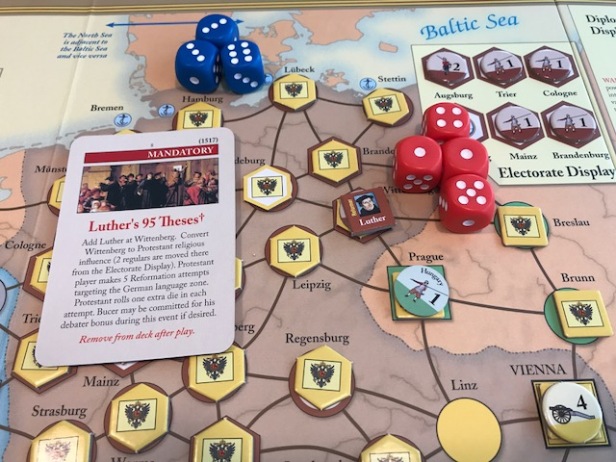
Also, during the opening round, there is a special Turn 1 only segment called the Diet of Wurms that is also very key for the Protestant player.
Why am I bringing up those start of game elements at this point when I started the section with the heading Victory?!? Well, victory cannot be determined in the first round, but the major points that will measure end game victory are focused on from the outset. If during the Victory Determination Segment of the Sequence of Play, a power’s VP total is less than 20 but is at least 8VP greater than the other power, they win a Domination Victory. This type of victory can only occur though in the Victory Determination phase of Turn 4 or later. You don’t check for this type of victory in Turns 1-3 and it is not common. Victory usually comes due to victory points eclipsing 25. If no player has gained the 25 VP minimum for victory at the end of Turn 9, the power with the most VP wins.

VP come from different sources for each of the Protestant and Papal player, and I really like this asymmetric design choice. The Protestant player is trying to gain VP from various religious activities, but mostly from having their Religious influence marker in as many spaces as possible. If the Protestant ever reaches 50 spaces, they score an auto win but more than likely will score points based on how many spaces they control. As you can see from the below picture, as the Protestant controls more spaces, the VPs increase but are not a 1 for 1 increase. The values listed at the top of each space is the number of controlled spaces. You will then see two numbers below that line, one on the left, which represents the VP for the Papal player and one on the right, which represents the Protestant VP. As the Protestant gains more spaces, the Papal player will lose VP and vice versa. Lets simply look at the 20 space area. When 20 spaces are controlled by the Protestant player, the Papal player will get 9 VP while the Protestant player will get 6. Compare this then to the 30 space where the Papal player will get only 6VP and the Protestant will get 9VP. This will be where a majority of the VP will come from and is very important for both players to focus on the “Holy War” side of the game or the struggle over the religious control of spaces.
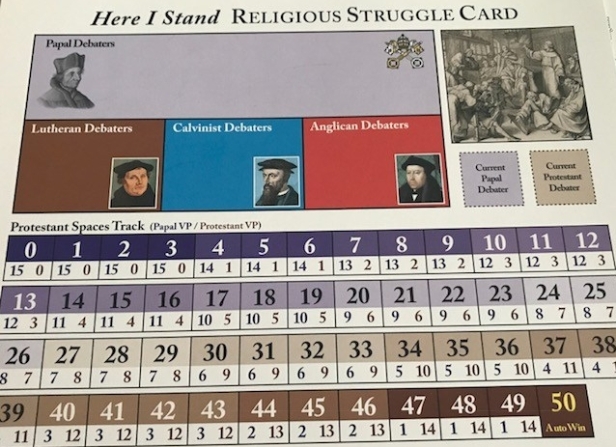
Both players will also gain VP from others sources, such as when the Protestant player translates the Bible in various languages, they will gain 1VP per language. Or when the Papal player renovates another level of St. Peter’s Basilica, they will gain 1 VP but can never gain more than 5VP for this action. Each side can also gain VP by disgracing or burning at the stake various religious leaders as a condition of Theological Debates (check out our Action Point 3 for more information on this aspect). After all of these elements VPs are totaled, you can declare a winner. In the 2-player variant, bonus VP from winning battles are few and far between, although they definitely can be earned.
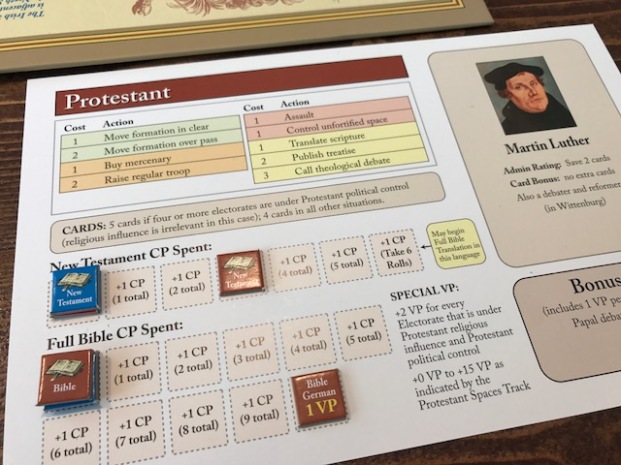
Summary and Conclusion
We have had a great experience with the 2-player variant included in the 500th Anniversary Edition of Here I Stand: Wars of the Reformation. But, I’m afraid to report that the 2-player experience is not really Here I Stand, but is rather a fun, quick and engaging alternative focused on the Protestant/Catholic wars of the Reformation. As I mentioned before, the real meat of Here I Stand, and the part that makes the game so great in the eyes of so many, is the player interaction, including alliances, deal making (I won’t attack you, if you attack him!) and backstabbing. For that experience, you really need to have more than 4 players and the game is really meant to shine at 6 players.
I would say that the 2-player variant is mostly to be used as a training attempt at learning the major rules and flow of the game. It will definitely teach all aspects of the greater game, but can be played in under 3 hours, as compared to a longer, more protracted 6 player game that can take upwards of 8-10 hours.
But, don’t be scared off. If you can only get 2 players together, this game is very fun and we really have enjoyed our 2 plays of the variant. It gave us a great introduction into the structure and function of the rules and left us wanting more. I have not made much progress in breaking down the inhibitions of the rest of our group to take the plunge into an all day Saturday game, but I have not given up hope just yet. We will keep trying to wear them down and will eventually get this majestic game to the table to experience Ed Beach’s grand vision of the Wars of the Reformation.
If you want to get a better idea of our initial thoughts following our first play of the game, you can check out our video review. Thanks for reading.
-Grant
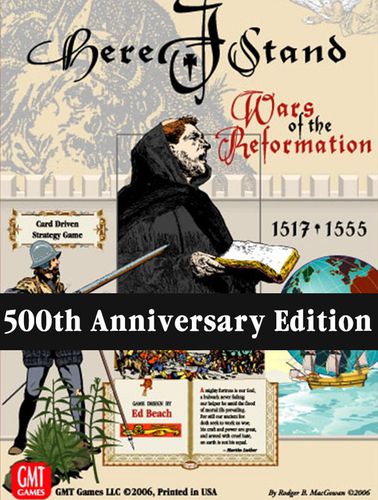
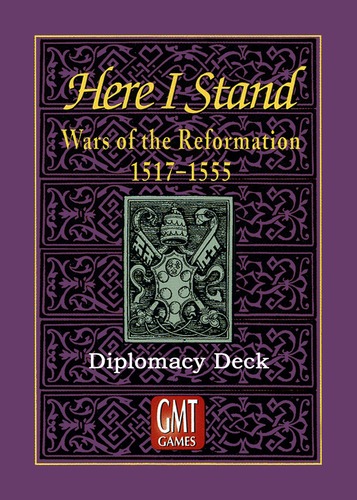
Thanks for this thoroughly thought out and written post sir. You just added this game to our wishlist.
LikeLike
Glad to oblige you. Hope you enjoy playing it. I know we did. Thanks for reading.
LikeLike
Nice review! And good luck finding the necessary players for a multiplayer game! From what I hear, three players works almost as well as six, so you are only one acolyte short!
LikeLiked by 1 person
But I really want to play a six player game. Maybe at WBC or Weekend at the Warehouse. Thanks for reading.
LikeLike
“One of the biggest changes in the reprint edition though is the inclusion of a previously released 2-player variant…”
At risk of being quite nitpicky, this is not a change in the 500th Anniversary Edition. The 2010 edition of the game also included the Diplomacy Deck. The original 2006 edition did not.
LikeLike
Great review! I have debated getting this game, because I know it will never get played (even 2-player), but it feels so cool.
One issue with the review, though.
“Victory
I have referred to the 2-player variant as “Holy War for Two in Under 3 Hours”. This is an apt description of the game as it pits the Protestants versus the Papacy. The two players will fight for the control of Germany during the first few rounds and will doggedly try their best to”
I think you’re missing a few words there at the end of the paragraph. 🙂
LikeLike
LOL. Thanks for pointing that out. Must have had a distraction and thought it was complete. I fixed it. Embarrassing!
LikeLiked by 1 person
Nah, we’ve all done it. 🙂
LikeLiked by 1 person